seats DODGE GRAND CARAVAN 2008 5.G Owners Manual
[x] Cancel search | Manufacturer: DODGE, Model Year: 2008, Model line: GRAND CARAVAN, Model: DODGE GRAND CARAVAN 2008 5.GPages: 531, PDF Size: 7.72 MB
Page 45 of 531
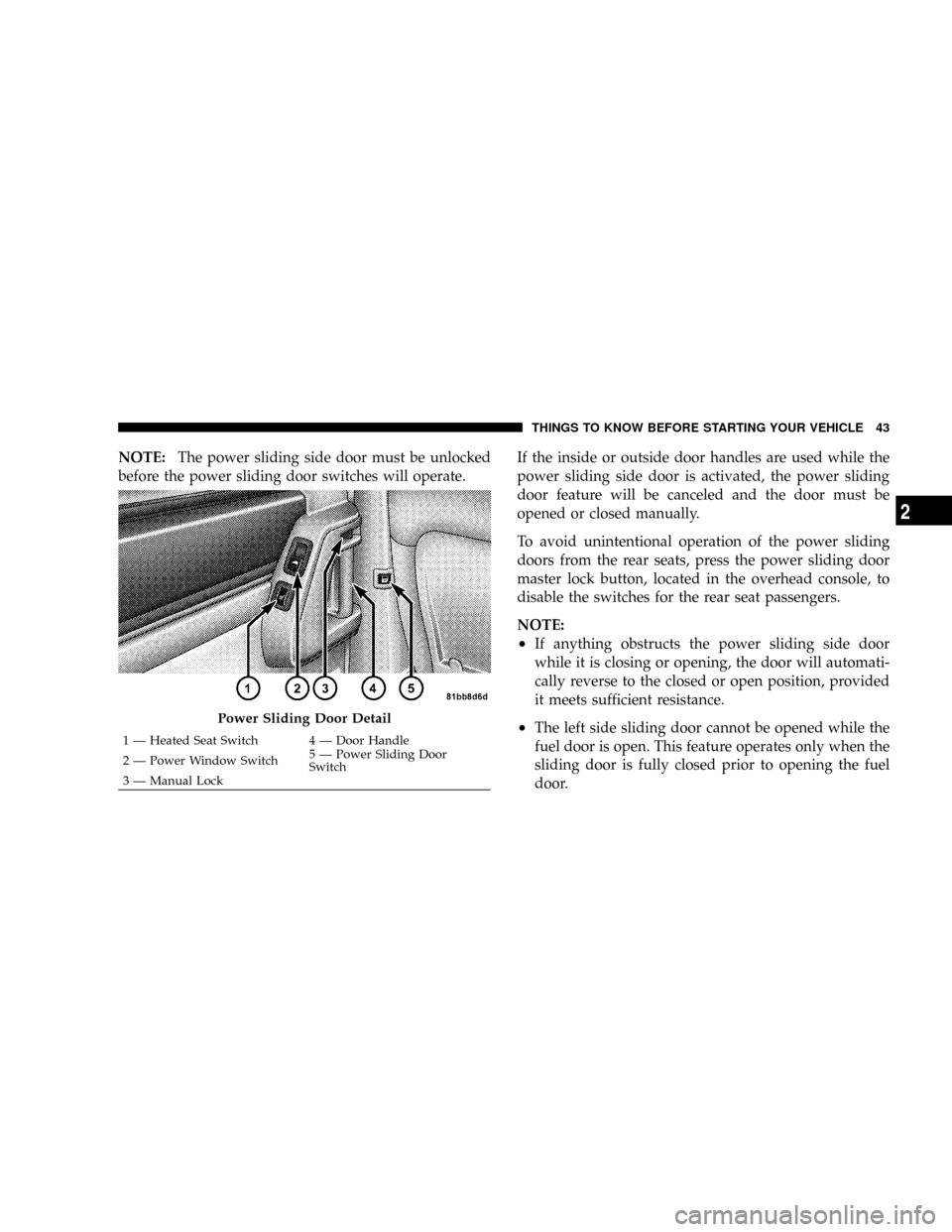
NOTE:The power sliding side door must be unlocked
before the power sliding door switches will operate.If the inside or outside door handles are used while the
power sliding side door is activated, the power sliding
door feature will be canceled and the door must be
opened or closed manually.
To avoid unintentional operation of the power sliding
doors from the rear seats, press the power sliding door
master lock button, located in the overhead console, to
disable the switches for the rear seat passengers.
NOTE:
²If anything obstructs the power sliding side door
while it is closing or opening, the door will automati-
cally reverse to the closed or open position, provided
it meets sufficient resistance.
²The left side sliding door cannot be opened while the
fuel door is open. This feature operates only when the
sliding door is fully closed prior to opening the fuel
door.Power Sliding Door Detail
1 Ð Heated Seat Switch 4 Ð Door Handle
2 Ð Power Window Switch5 Ð Power Sliding Door
Switch
3 Ð Manual LockTHINGS TO KNOW BEFORE STARTING YOUR VEHICLE 43
2
Page 47 of 531
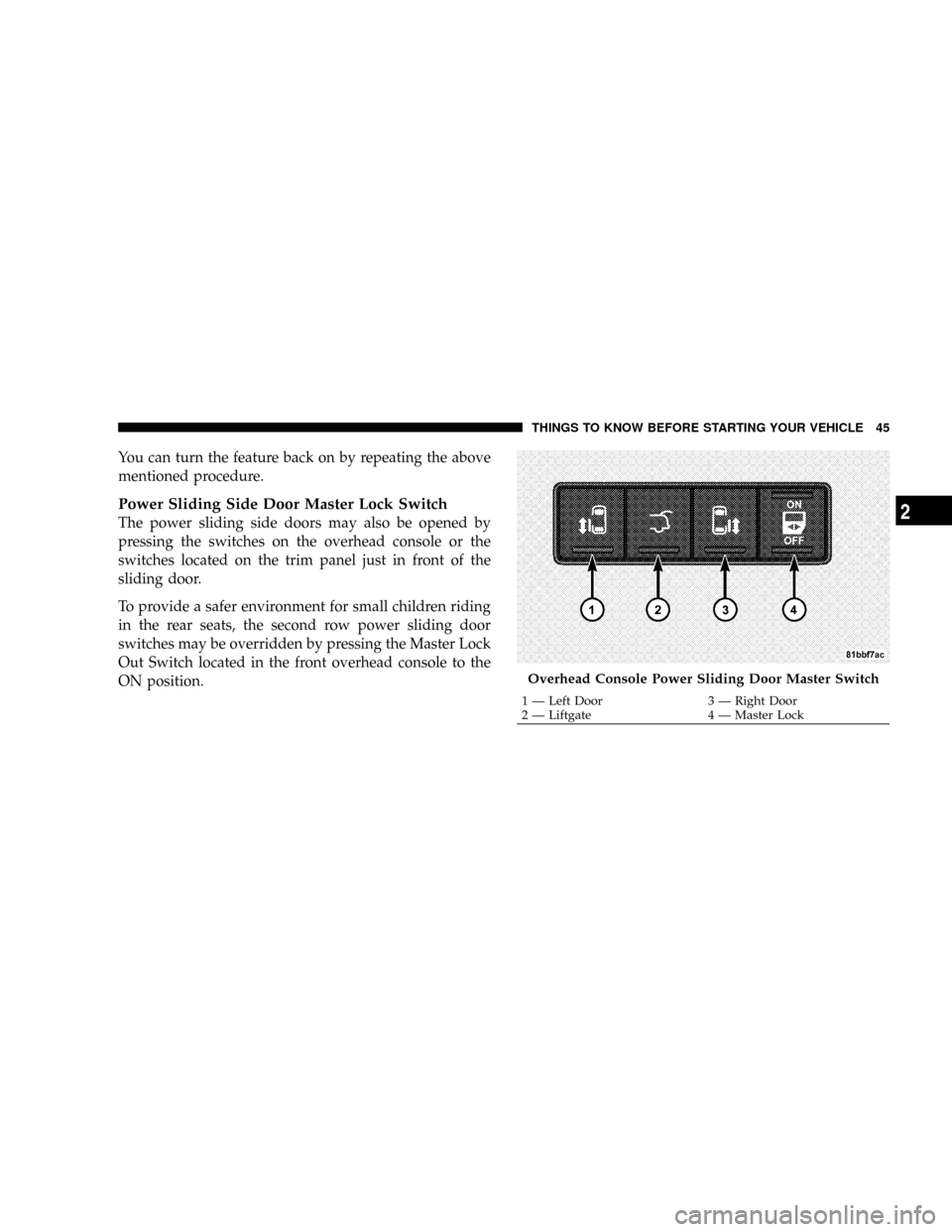
You can turn the feature back on by repeating the above
mentioned procedure.
Power Sliding Side Door Master Lock Switch
The power sliding side doors may also be opened by
pressing the switches on the overhead console or the
switches located on the trim panel just in front of the
sliding door.
To provide a safer environment for small children riding
in the rear seats, the second row power sliding door
switches may be overridden by pressing the Master Lock
Out Switch located in the front overhead console to the
ON position.
Overhead Console Power Sliding Door Master Switch
1 Ð Left Door 3 Ð Right Door
2 Ð Liftgate 4 Ð Master LockTHINGS TO KNOW BEFORE STARTING YOUR VEHICLE 45
2
Page 48 of 531
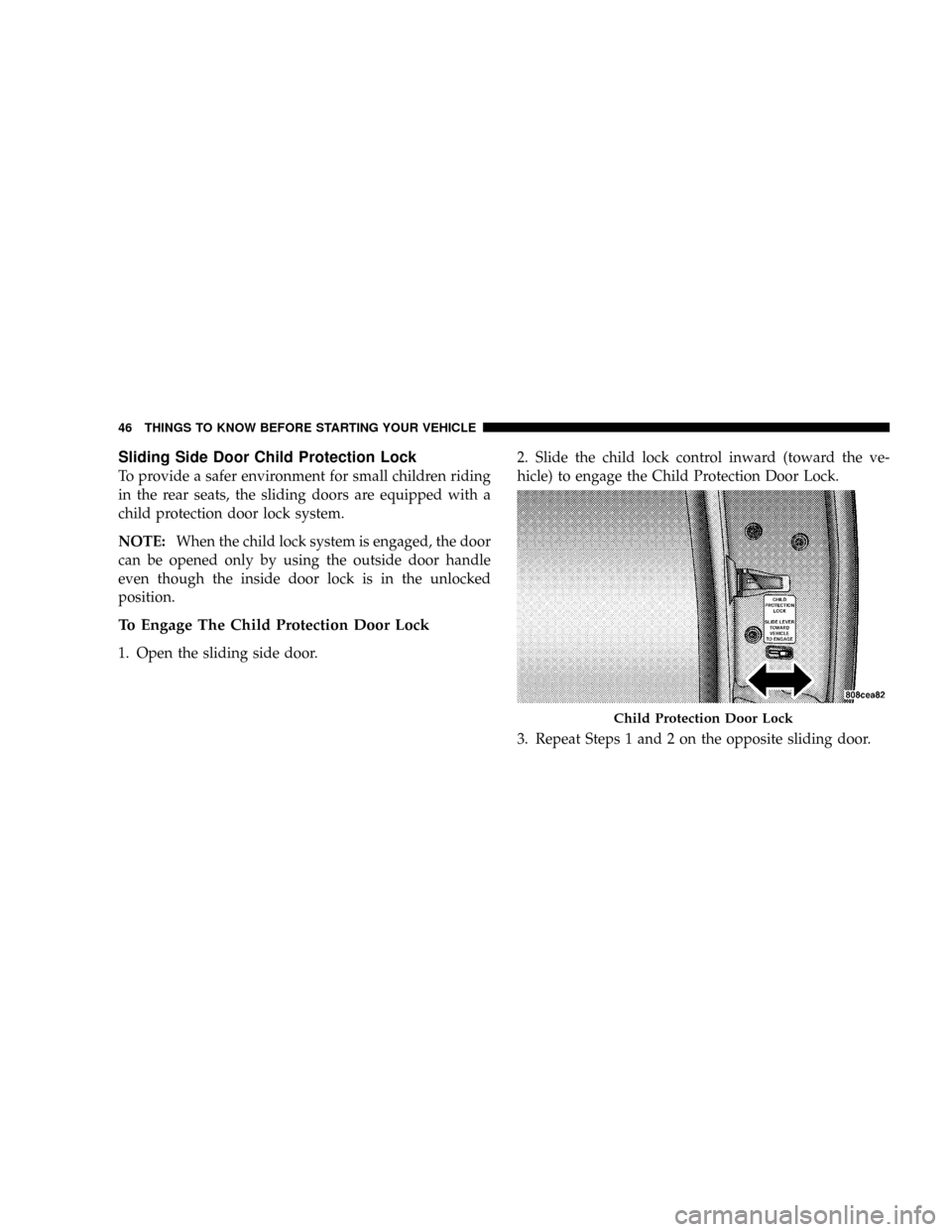
Sliding Side Door Child Protection Lock
To provide a safer environment for small children riding
in the rear seats, the sliding doors are equipped with a
child protection door lock system.
NOTE:When the child lock system is engaged, the door
can be opened only by using the outside door handle
even though the inside door lock is in the unlocked
position.
To Engage The Child Protection Door Lock
1. Open the sliding side door.2. Slide the child lock control inward (toward the ve-
hicle) to engage the Child Protection Door Lock.
3. Repeat Steps 1 and 2 on the opposite sliding door.
Child Protection Door Lock
46 THINGS TO KNOW BEFORE STARTING YOUR VEHICLE
Page 49 of 531
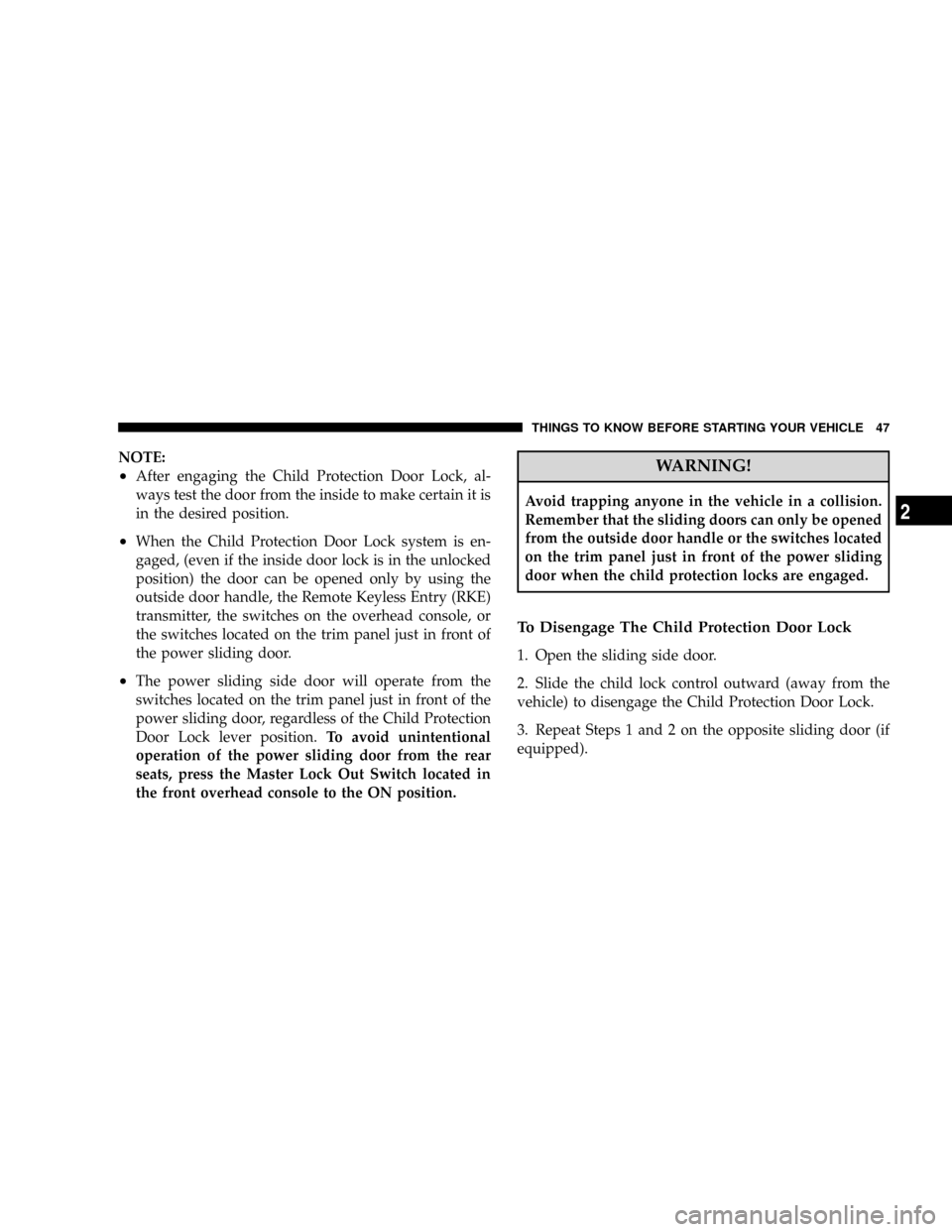
NOTE:
²After engaging the Child Protection Door Lock, al-
ways test the door from the inside to make certain it is
in the desired position.
²When the Child Protection Door Lock system is en-
gaged, (even if the inside door lock is in the unlocked
position) the door can be opened only by using the
outside door handle, the Remote Keyless Entry (RKE)
transmitter, the switches on the overhead console, or
the switches located on the trim panel just in front of
the power sliding door.
²The power sliding side door will operate from the
switches located on the trim panel just in front of the
power sliding door, regardless of the Child Protection
Door Lock lever position.To avoid unintentional
operation of the power sliding door from the rear
seats, press the Master Lock Out Switch located in
the front overhead console to the ON position.
WARNING!
Avoid trapping anyone in the vehicle in a collision.
Remember that the sliding doors can only be opened
from the outside door handle or the switches located
on the trim panel just in front of the power sliding
door when the child protection locks are engaged.
To Disengage The Child Protection Door Lock
1. Open the sliding side door.
2. Slide the child lock control outward (away from the
vehicle) to disengage the Child Protection Door Lock.
3. Repeat Steps 1 and 2 on the opposite sliding door (if
equipped).
THINGS TO KNOW BEFORE STARTING YOUR VEHICLE 47
2
Page 59 of 531
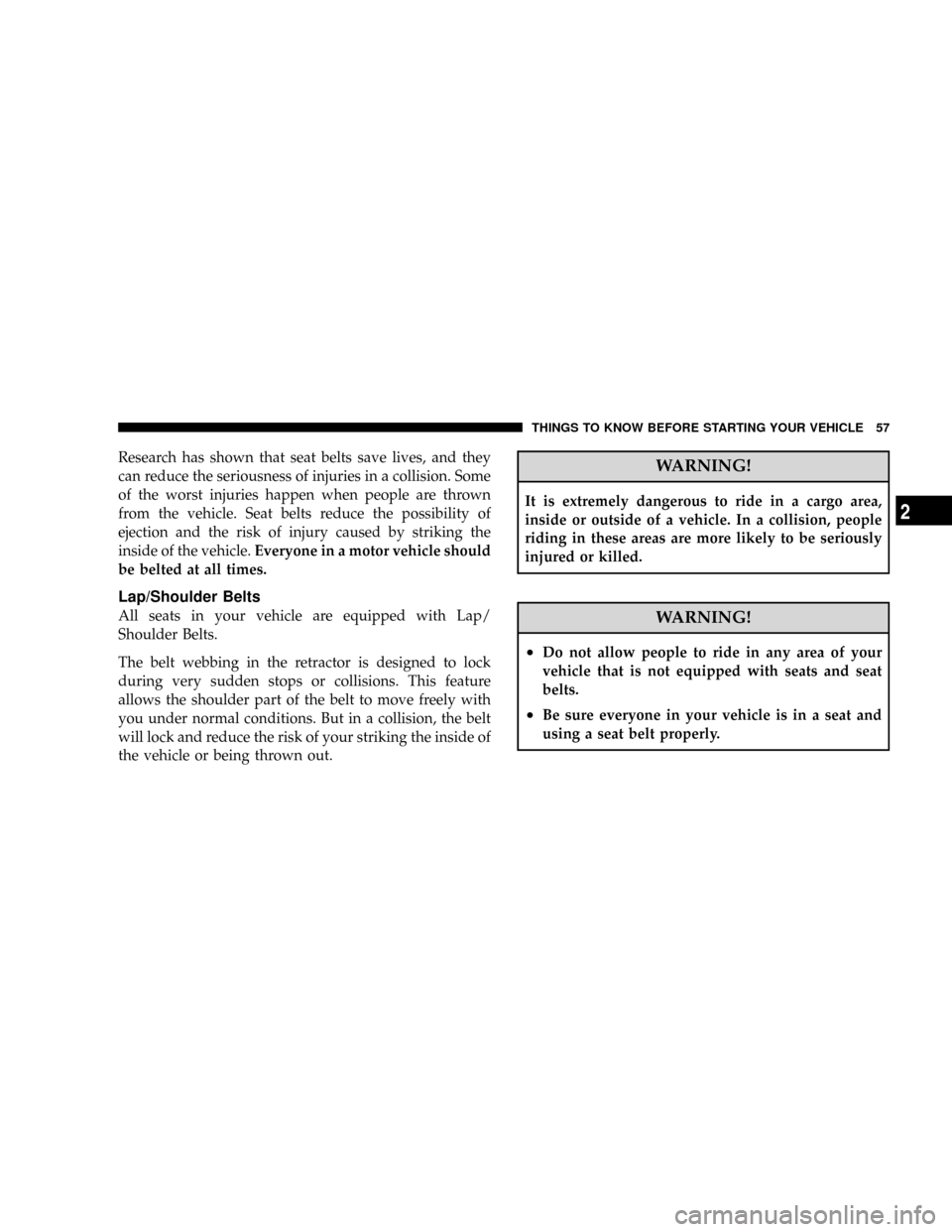
Research has shown that seat belts save lives, and they
can reduce the seriousness of injuries in a collision. Some
of the worst injuries happen when people are thrown
from the vehicle. Seat belts reduce the possibility of
ejection and the risk of injury caused by striking the
inside of the vehicle.Everyone in a motor vehicle should
be belted at all times.
Lap/Shoulder Belts
All seats in your vehicle are equipped with Lap/
Shoulder Belts.
The belt webbing in the retractor is designed to lock
during very sudden stops or collisions. This feature
allows the shoulder part of the belt to move freely with
you under normal conditions. But in a collision, the belt
will lock and reduce the risk of your striking the inside of
the vehicle or being thrown out.
WARNING!
It is extremely dangerous to ride in a cargo area,
inside or outside of a vehicle. In a collision, people
riding in these areas are more likely to be seriously
injured or killed.
WARNING!
²Do not allow people to ride in any area of your
vehicle that is not equipped with seats and seat
belts.
²Be sure everyone in your vehicle is in a seat and
using a seat belt properly.
THINGS TO KNOW BEFORE STARTING YOUR VEHICLE 57
2
Page 61 of 531
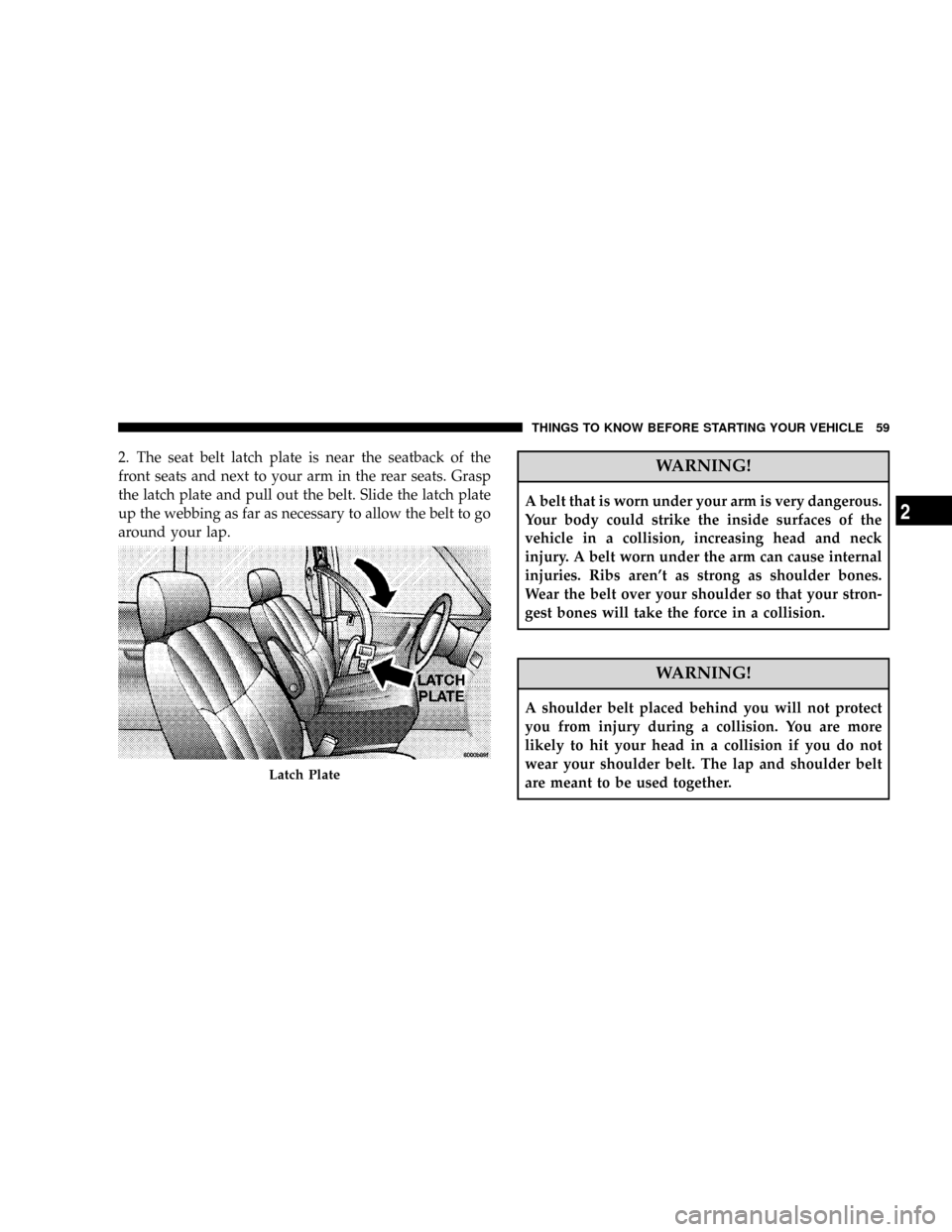
2. The seat belt latch plate is near the seatback of the
front seats and next to your arm in the rear seats. Grasp
the latch plate and pull out the belt. Slide the latch plate
up the webbing as far as necessary to allow the belt to go
around your lap.WARNING!
A belt that is worn under your arm is very dangerous.
Your body could strike the inside surfaces of the
vehicle in a collision, increasing head and neck
injury. A belt worn under the arm can cause internal
injuries. Ribs aren't as strong as shoulder bones.
Wear the belt over your shoulder so that your stron-
gest bones will take the force in a collision.
WARNING!
A shoulder belt placed behind you will not protect
you from injury during a collision. You are more
likely to hit your head in a collision if you do not
wear your shoulder belt. The lap and shoulder belt
are meant to be used together.
Latch Plate
THINGS TO KNOW BEFORE STARTING YOUR VEHICLE 59
2
Page 64 of 531
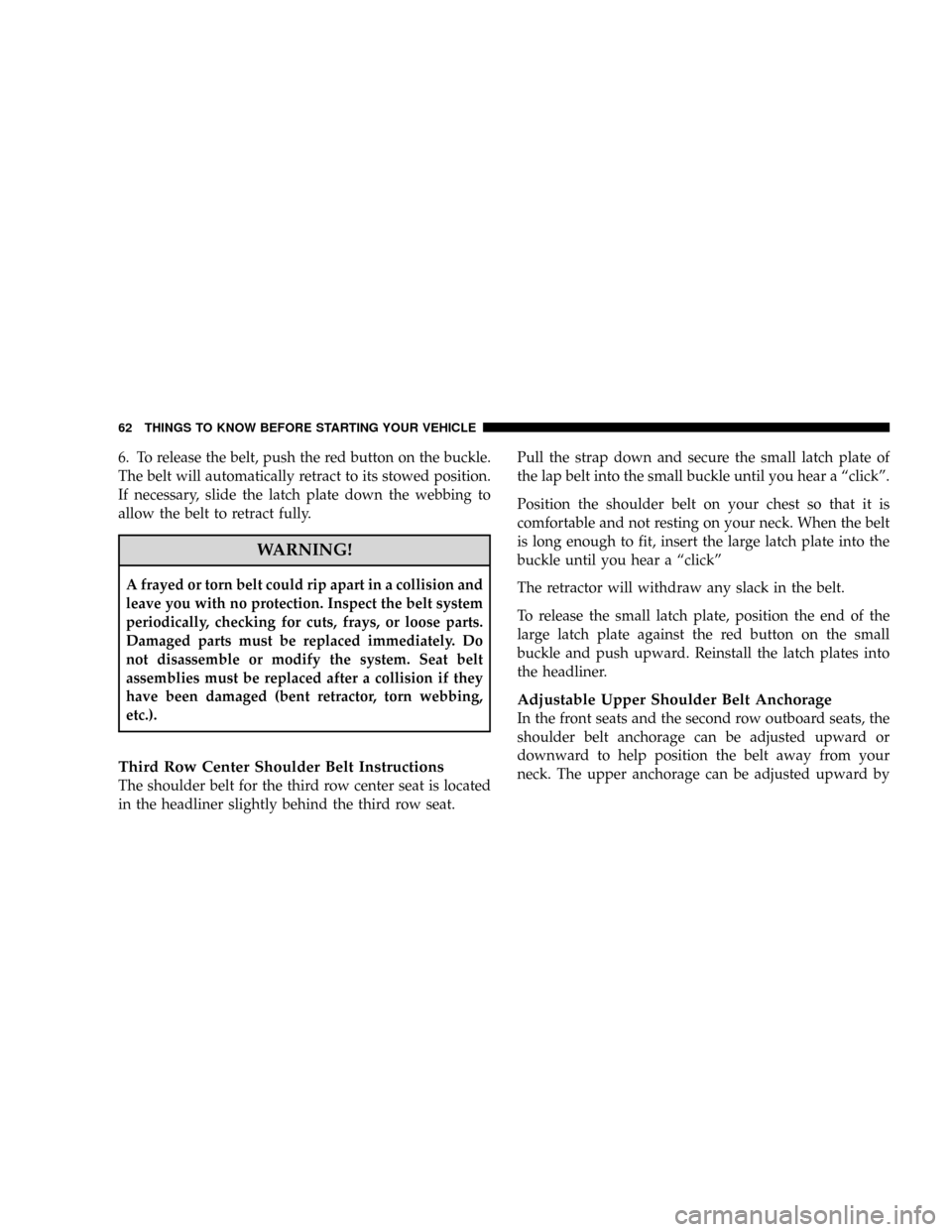
6. To release the belt, push the red button on the buckle.
The belt will automatically retract to its stowed position.
If necessary, slide the latch plate down the webbing to
allow the belt to retract fully.
WARNING!
A frayed or torn belt could rip apart in a collision and
leave you with no protection. Inspect the belt system
periodically, checking for cuts, frays, or loose parts.
Damaged parts must be replaced immediately. Do
not disassemble or modify the system. Seat belt
assemblies must be replaced after a collision if they
have been damaged (bent retractor, torn webbing,
etc.).
Third Row Center Shoulder Belt Instructions
The shoulder belt for the third row center seat is located
in the headliner slightly behind the third row seat.Pull the strap down and secure the small latch plate of
the lap belt into the small buckle until you hear a ªclickº.
Position the shoulder belt on your chest so that it is
comfortable and not resting on your neck. When the belt
is long enough to fit, insert the large latch plate into the
buckle until you hear a ªclickº
The retractor will withdraw any slack in the belt.
To release the small latch plate, position the end of the
large latch plate against the red button on the small
buckle and push upward. Reinstall the latch plates into
the headliner.
Adjustable Upper Shoulder Belt Anchorage
In the front seats and the second row outboard seats, the
shoulder belt anchorage can be adjusted upward or
downward to help position the belt away from your
neck. The upper anchorage can be adjusted upward by
62 THINGS TO KNOW BEFORE STARTING YOUR VEHICLE
Page 73 of 531
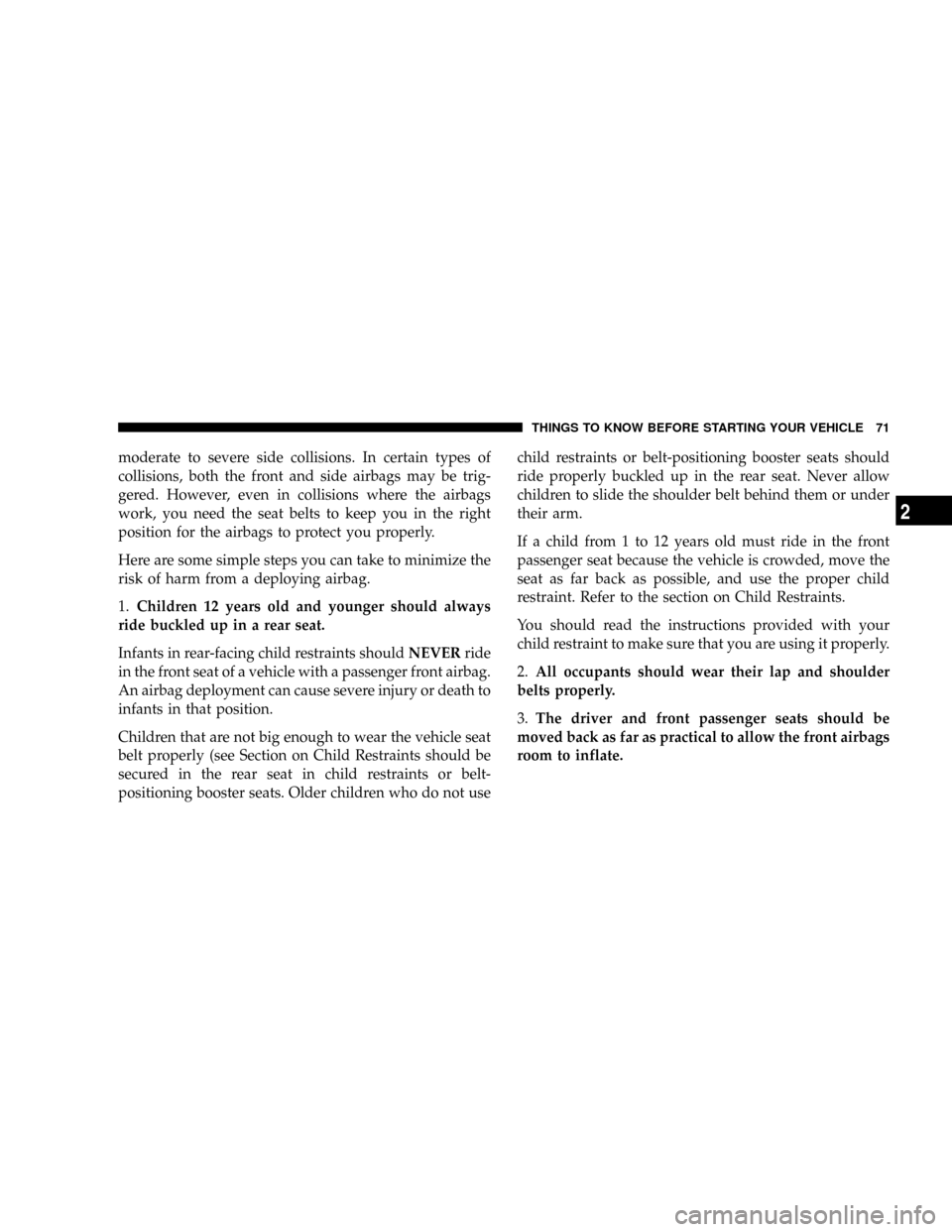
moderate to severe side collisions. In certain types of
collisions, both the front and side airbags may be trig-
gered. However, even in collisions where the airbags
work, you need the seat belts to keep you in the right
position for the airbags to protect you properly.
Here are some simple steps you can take to minimize the
risk of harm from a deploying airbag.
1.Children 12 years old and younger should always
ride buckled up in a rear seat.
Infants in rear-facing child restraints shouldNEVERride
in the front seat of a vehicle with a passenger front airbag.
An airbag deployment can cause severe injury or death to
infants in that position.
Children that are not big enough to wear the vehicle seat
belt properly (see Section on Child Restraints should be
secured in the rear seat in child restraints or belt-
positioning booster seats. Older children who do not usechild restraints or belt-positioning booster seats should
ride properly buckled up in the rear seat. Never allow
children to slide the shoulder belt behind them or under
their arm.
If a child from 1 to 12 years old must ride in the front
passenger seat because the vehicle is crowded, move the
seat as far back as possible, and use the proper child
restraint. Refer to the section on Child Restraints.
You should read the instructions provided with your
child restraint to make sure that you are using it properly.
2.All occupants should wear their lap and shoulder
belts properly.
3.The driver and front passenger seats should be
moved back as far as practical to allow the front airbags
room to inflate.
THINGS TO KNOW BEFORE STARTING YOUR VEHICLE 71
2
Page 83 of 531
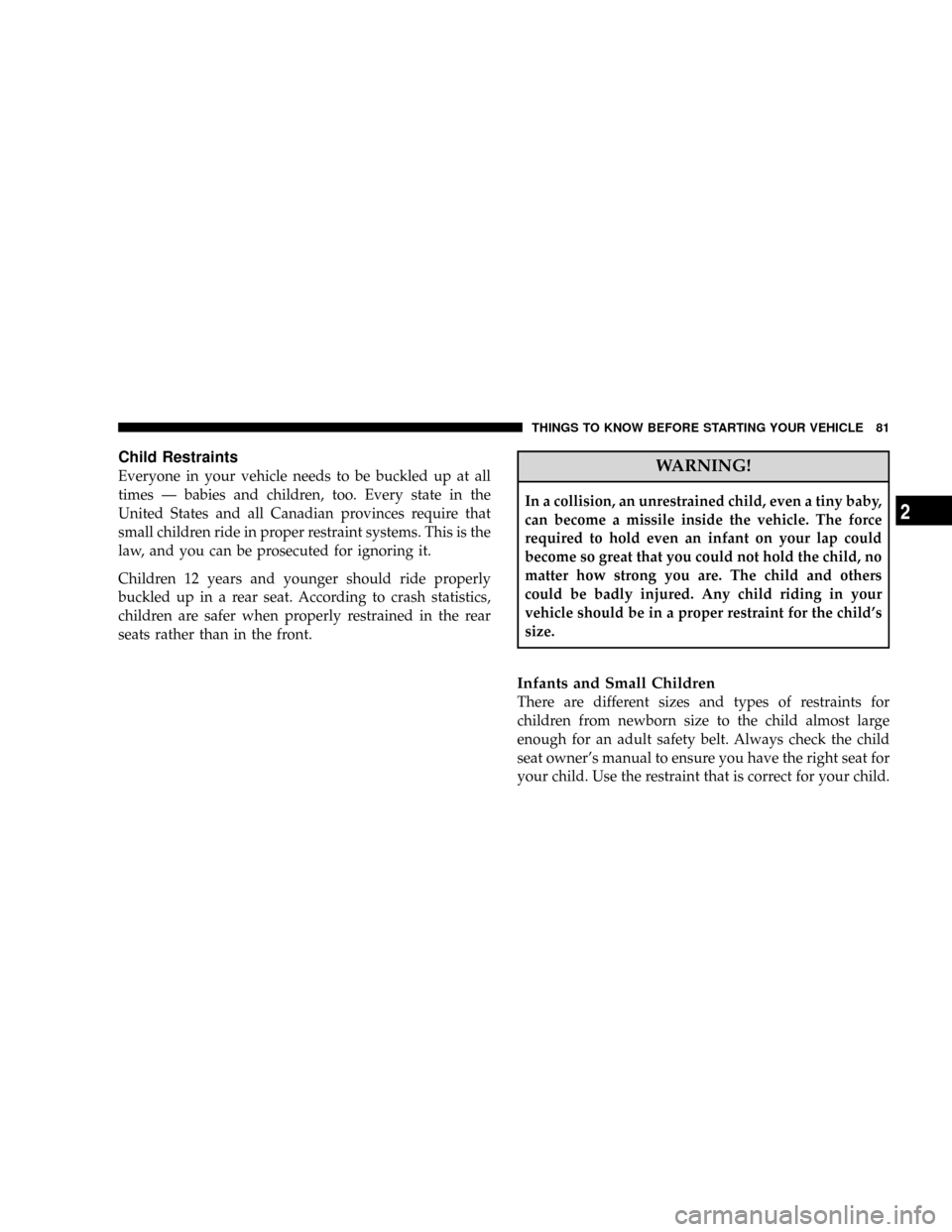
Child Restraints
Everyone in your vehicle needs to be buckled up at all
times Ð babies and children, too. Every state in the
United States and all Canadian provinces require that
small children ride in proper restraint systems. This is the
law, and you can be prosecuted for ignoring it.
Children 12 years and younger should ride properly
buckled up in a rear seat. According to crash statistics,
children are safer when properly restrained in the rear
seats rather than in the front.WARNING!
In a collision, an unrestrained child, even a tiny baby,
can become a missile inside the vehicle. The force
required to hold even an infant on your lap could
become so great that you could not hold the child, no
matter how strong you are. The child and others
could be badly injured. Any child riding in your
vehicle should be in a proper restraint for the child's
size.
Infants and Small Children
There are different sizes and types of restraints for
children from newborn size to the child almost large
enough for an adult safety belt. Always check the child
seat owner's manual to ensure you have the right seat for
your child. Use the restraint that is correct for your child.
THINGS TO KNOW BEFORE STARTING YOUR VEHICLE 81
2
Page 84 of 531
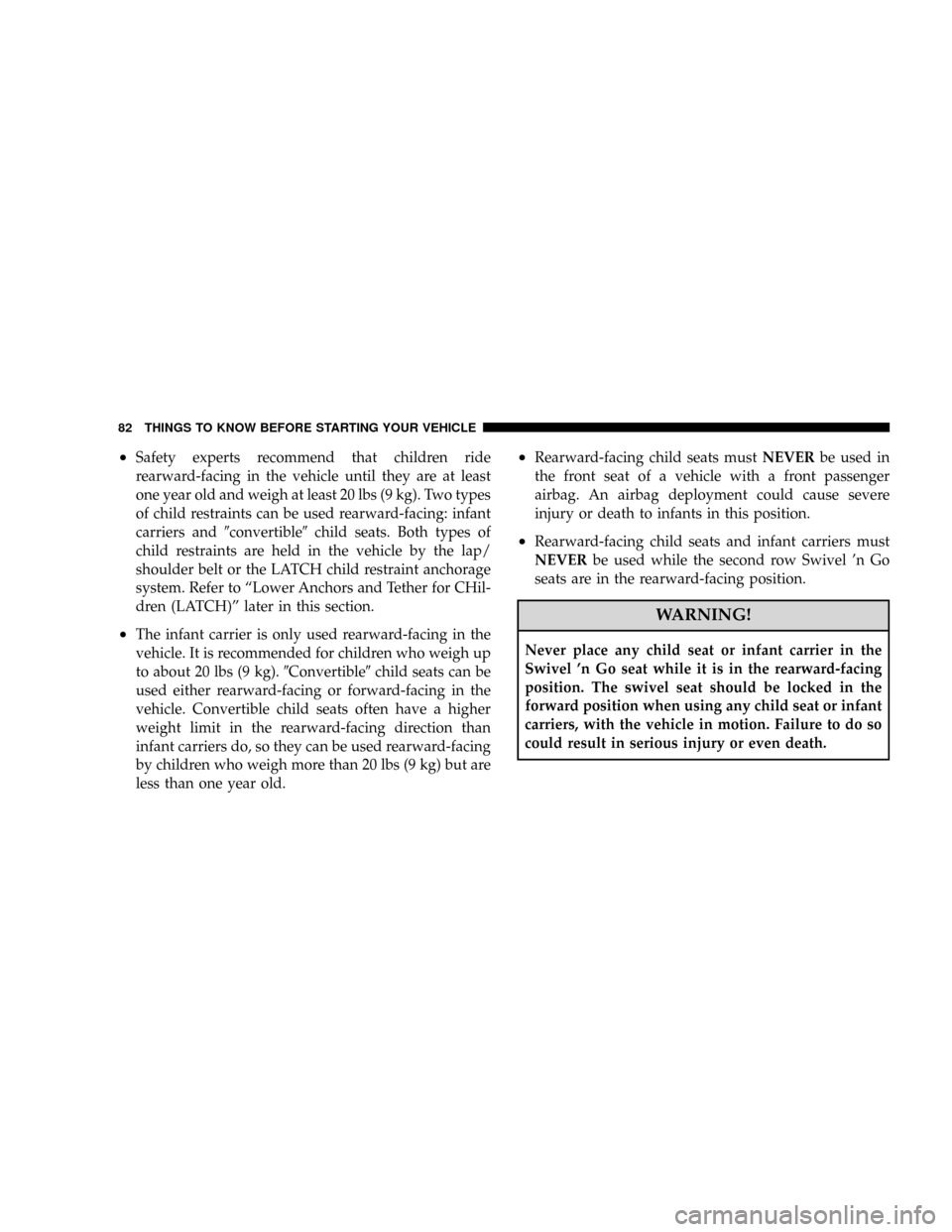
²Safety experts recommend that children ride
rearward-facing in the vehicle until they are at least
one year old and weigh at least 20 lbs (9 kg). Two types
of child restraints can be used rearward-facing: infant
carriers and9convertible9child seats. Both types of
child restraints are held in the vehicle by the lap/
shoulder belt or the LATCH child restraint anchorage
system. Refer to ªLower Anchors and Tether for CHil-
dren (LATCH)º later in this section.
²The infant carrier is only used rearward-facing in the
vehicle. It is recommended for children who weigh up
to about 20 lbs (9 kg).9Convertible9child seats can be
used either rearward-facing or forward-facing in the
vehicle. Convertible child seats often have a higher
weight limit in the rearward-facing direction than
infant carriers do, so they can be used rearward-facing
by children who weigh more than 20 lbs (9 kg) but are
less than one year old.
²Rearward-facing child seats mustNEVERbe used in
the front seat of a vehicle with a front passenger
airbag. An airbag deployment could cause severe
injury or death to infants in this position.
²Rearward-facing child seats and infant carriers must
NEVERbe used while the second row Swivel 'n Go
seats are in the rearward-facing position.
WARNING!
Never place any child seat or infant carrier in the
Swivel 'n Go seat while it is in the rearward-facing
position. The swivel seat should be locked in the
forward position when using any child seat or infant
carriers, with the vehicle in motion. Failure to do so
could result in serious injury or even death.
82 THINGS TO KNOW BEFORE STARTING YOUR VEHICLE